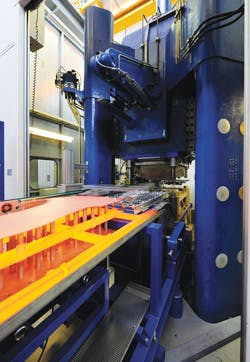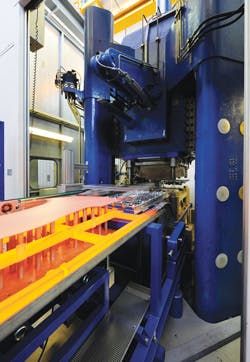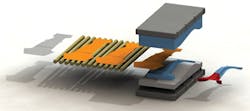Laser technologies in the hot stamping process chain
Efficient solutions have led to widespread adoption
Stefan Wischmann and Franz-Josef Lenze
The rising requirements of legislation in the EU, the US, and other countries to reduce the greenhouse gas emissions of motor vehicles have started a global trend that increases the pressure on the auto industry to significantly reduce the weight of its products. At the same time, demands on performance and crash safety are also continuing to rise. In the past, meeting these demands has resulted in considerable weight increases. Resolving these conflicting requirements while also taking cost aspects into account is a development challenge that the steel industry is helping to meet with new products and adapted processing technologies.
In the past decade, the hot stamping of auto body parts has evolved from a niche technology into one that is now indispensable for weight reduction with high-strength steel. This evolution has resulted in significant reductions in vehicle weight, made possible by the extremely high strengths of the steels used. The development efforts of steel manufacturers in the field of manganese-boron steels were a pre-requisite for this.
New challenges
From the users' viewpoint, the increasingly widespread use of these manganese-boron steels and their improved coatings poses diverse new challenges for the hot stamping process chain in general and for laser technology in particular. The different processing conditions required by manganese-boron steels compared with the cold stamping steels previously used, and their widely varying properties depending on the carbon content in the individual processing steps, particularly under the influence of heat, showed a need for corresponding process development.
This concerns the use of lasers, beginning with the manufacture of welded manganese-boron steel blanks, so-called Hotform Blanks. These blanks are produced by laser welding and are manufactured in very large volumes in different material thicknesses and also in combinations with other steel grades. From a metallurgical viewpoint, it is important to mention the hardening effect caused by martensite formation due to the high carbon content and rapid cooling. However, this hardening does not have a disruptive effect on subsequent processing by hot stamping as the temperatures in the furnace are above austenitization temperature (AC3) and the cooling rates in the die during subsequent stamping result in a homogeneous martensitic microstructure throughout the part, including the laser weld (see FIGURE 1). However, it is well known that edge preparation, geometric accuracy, and coatings are keys to the quality of the laser weld.
In the case of the above hot stamping steels, a high-melting-point aluminum-silicon (AS) coating is used to protect the steel in the furnace. However, this affects the laser weld metal deposit so unfavorably that the coating has to be removed prior to the welding process. Lasers have proven a successful high-energy tool for this as well. In production equipment, Q-switched lasers achieve full decoating of the blank edges. In addition, the LIPS process (laser induced plasma spectroscopy) is used for quality monitoring. In this process, the areas of the blanks to be decoated are bombarded with Nd:YAG lasers with pulse lengths in the nanosecond range and the metal vapor plasma produced is analyzed by spectroscopy to determine the aluminum content. Another proven method is to monitor the weld plasma in the subsequent laser welding process.
Other approaches
In addition to the use of the above-mentioned Hotform Blanks, other developments have taken place in hot stamping aimed at matching functional strength to crash requirements. Relevant processes include tailored tempering, in which the cooling rate in the die is varied, and furnace technologies that allow different starting temperatures for the press hardening operation. Both processes produce different microstructure zones in the part (FIGURE 2).
Another approach is to produce these different microstructure zones after hot stamping. The advantage lies in greatly increased degrees of freedom in part configuration. This can be achieved by hardening unhardened microstructure zones or by softening hardened microstructure zones. In a project sponsored by the Federal Ministry for Education and Research called "Local heat treatment of sheet materials to improve forming and functional properties," this was demonstrated effectively by means of induction and laser techniques. The laser material treatment used linear diode lasers of the kind also used for hardening high-carbon tool steels. This configuration allows high 3D capabilities with high surface treatment speeds.
Looking at the steps downstream of the hot stamping process chain, it is necessary in most cases to trim the parts. Due to the high hardness and the associated high wear in conventional mechanical trimming operations, this should be carried out in unhardened microstructure zones. As this is often not possible, lasers have proven widely successful as a "wear-free" tool despite the disadvantage of lower output. In other applications, for example, cutting blanks to size, a number of factors favor trimming by laser rather than by mechanical press:
- lower investment cost,
- lower cost per part,
- higher flexibility when starting production and in low-volume runs,
- shorter setup times for part changes,
- optimized storage costs and batch sizes, and
- no wear through contact cutting when processing high-strength steels.
The lower output is mainly due to the cutting speed. To offset this disadvantage, users favor a variety of specific solutions, ranging from parallelization of the process and equipment modifications to new developments such as remote laser cutting.
The final use of lasers in processing hot-stamped manganese-boron steels takes place during welding in the body-in-white line. Here, laser welding has established itself alongside conventional methods such as resistance spot welding. It should be noted that, in the region of the weld deposit, high cooling rates again result in martensite formation and hence in hardness and strength levels corresponding to the hardened condition of the part. Heat input from the welding process into the hardened base metal is problematic. This leads to a tempering effect in the heat-affected zone and hence to a metallurgical notch that must be taken into account in part design. FIGURE 3 is a hardness profile of a laser beam weld in hardened manganese-boron steel (MBW 1500 +AS).
In summary, it can be stated that the use of laser technologies has led to efficient solutions in the hot stamping process chain and contributed greatly to the widespread adoption of hot stamping.
Stefan Wischmann([email protected]) and Dr. Franz-Josef Lenze are with ThyssenKrupp Steel Europe AG, Duisburg, Germany.
More Industrial Laser Solutions Current Issue Articles
More Industrial Laser Solutions Archives Issue Articles



